[English] 日本語
 Yorodumi
Yorodumi- PDB-5tq2: Crystal structure of amino terminal domains of the NMDA receptor ... -
+ Open data
Open data
- Basic information
Basic information
| Entry | Database: PDB / ID: 5tq2 | |||||||||
|---|---|---|---|---|---|---|---|---|---|---|
| Title | Crystal structure of amino terminal domains of the NMDA receptor subunit GluN1 and GluN2A in complex with zinc at GluN1 and GluN2A | |||||||||
 Components Components |
| |||||||||
 Keywords Keywords | TRANSPORT PROTEIN / ION CHANNEL / NMDA RECEPTOR / ALLOSTERIC MODULATION / ZINC INHIBITION | |||||||||
| Function / homology |  Function and homology information Function and homology informationneurotransmitter receptor transport, plasma membrane to endosome / regulation of response to alcohol / response to ammonium ion / receptor recycling / response to environmental enrichment / directional locomotion / Assembly and cell surface presentation of NMDA receptors / response to hydrogen sulfide / auditory behavior / response to other organism ...neurotransmitter receptor transport, plasma membrane to endosome / regulation of response to alcohol / response to ammonium ion / receptor recycling / response to environmental enrichment / directional locomotion / Assembly and cell surface presentation of NMDA receptors / response to hydrogen sulfide / auditory behavior / response to other organism / regulation of ARF protein signal transduction / protein localization to postsynaptic membrane / cellular response to magnesium ion / serotonin metabolic process / positive regulation of inhibitory postsynaptic potential / response to methylmercury / response to manganese ion / response to carbohydrate / sleep / dendritic spine organization / locomotion / cellular response to dsRNA / regulation of NMDA receptor activity / cellular response to lipid / regulation of monoatomic cation transmembrane transport / NMDA glutamate receptor activity / Synaptic adhesion-like molecules / voltage-gated monoatomic cation channel activity / response to glycoside / NMDA selective glutamate receptor complex / glutamate binding / ligand-gated sodium channel activity / response to zinc ion / glutamate receptor signaling pathway / calcium ion transmembrane import into cytosol / spinal cord development / response to amine / cellular response to zinc ion / startle response / parallel fiber to Purkinje cell synapse / dopamine metabolic process / monoatomic cation transmembrane transport / response to lithium ion / cellular response to glycine / modulation of excitatory postsynaptic potential / response to light stimulus / regulation of postsynaptic membrane potential / action potential / conditioned place preference / regulation of neuronal synaptic plasticity / glutamate receptor binding / positive regulation of protein targeting to membrane / Unblocking of NMDA receptors, glutamate binding and activation / positive regulation of excitatory postsynaptic potential / neuron development / positive regulation of synaptic transmission, glutamatergic / multicellular organismal response to stress / postsynaptic density, intracellular component / monoatomic cation channel activity / response to fungicide / glutamate-gated receptor activity / cell adhesion molecule binding / cellular response to manganese ion / glutamate-gated calcium ion channel activity / neurogenesis / dendrite membrane / sensory perception of pain / ligand-gated monoatomic ion channel activity involved in regulation of presynaptic membrane potential / ionotropic glutamate receptor signaling pathway / sodium ion transmembrane transport / protein tyrosine kinase binding / synaptic membrane / response to amphetamine / cytoplasmic vesicle membrane / regulation of membrane potential / learning / response to nicotine / response to cocaine / transmitter-gated monoatomic ion channel activity involved in regulation of postsynaptic membrane potential / synaptic transmission, glutamatergic / excitatory postsynaptic potential / hippocampus development / cellular response to amino acid stimulus / protein catabolic process / response to calcium ion / regulation of long-term neuronal synaptic plasticity / postsynaptic density membrane / cerebral cortex development / regulation of synaptic plasticity / visual learning / negative regulation of protein catabolic process / modulation of chemical synaptic transmission / calcium ion transmembrane transport / response to lead ion / response to wounding / cellular response to growth factor stimulus / calcium channel activity / memory / long-term synaptic potentiation / terminal bouton Similarity search - Function | |||||||||
| Biological species |   | |||||||||
| Method |  X-RAY DIFFRACTION / X-RAY DIFFRACTION /  SYNCHROTRON / SYNCHROTRON /  MOLECULAR REPLACEMENT / Resolution: 3.289 Å MOLECULAR REPLACEMENT / Resolution: 3.289 Å | |||||||||
 Authors Authors | Romero-Hernandez, A. / Simorowski, N. / Karakas, E. / Furukawa, H. | |||||||||
| Funding support |  United States, 2items United States, 2items
| |||||||||
 Citation Citation |  Journal: Neuron / Year: 2016 Journal: Neuron / Year: 2016Title: Molecular Basis for Subtype Specificity and High-Affinity Zinc Inhibition in the GluN1-GluN2A NMDA Receptor Amino-Terminal Domain. Authors: Romero-Hernandez, A. / Simorowski, N. / Karakas, E. / Furukawa, H. | |||||||||
| History |
|
- Structure visualization
Structure visualization
| Structure viewer | Molecule:  Molmil Molmil Jmol/JSmol Jmol/JSmol |
|---|
- Downloads & links
Downloads & links
- Download
Download
| PDBx/mmCIF format |  5tq2.cif.gz 5tq2.cif.gz | 226.8 KB | Display |  PDBx/mmCIF format PDBx/mmCIF format |
|---|---|---|---|---|
| PDB format |  pdb5tq2.ent.gz pdb5tq2.ent.gz | 171 KB | Display |  PDB format PDB format |
| PDBx/mmJSON format |  5tq2.json.gz 5tq2.json.gz | Tree view |  PDBx/mmJSON format PDBx/mmJSON format | |
| Others |  Other downloads Other downloads |
-Validation report
| Summary document |  5tq2_validation.pdf.gz 5tq2_validation.pdf.gz | 503.7 KB | Display |  wwPDB validaton report wwPDB validaton report |
|---|---|---|---|---|
| Full document |  5tq2_full_validation.pdf.gz 5tq2_full_validation.pdf.gz | 517.2 KB | Display | |
| Data in XML |  5tq2_validation.xml.gz 5tq2_validation.xml.gz | 39.3 KB | Display | |
| Data in CIF |  5tq2_validation.cif.gz 5tq2_validation.cif.gz | 53.9 KB | Display | |
| Arichive directory |  https://data.pdbj.org/pub/pdb/validation_reports/tq/5tq2 https://data.pdbj.org/pub/pdb/validation_reports/tq/5tq2 ftp://data.pdbj.org/pub/pdb/validation_reports/tq/5tq2 ftp://data.pdbj.org/pub/pdb/validation_reports/tq/5tq2 | HTTPS FTP |
-Related structure data
| Related structure data | 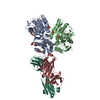 5tpwSC 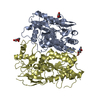 5tpzC 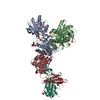 5tq0C C: citing same article ( S: Starting model for refinement |
|---|---|
| Similar structure data |
- Links
Links
- Assembly
Assembly
| Deposited unit | 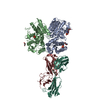
| ||||||||
|---|---|---|---|---|---|---|---|---|---|
| 1 |
| ||||||||
| Unit cell |
|
- Components
Components
-Protein , 2 types, 2 molecules AB
| #1: Protein | Mass: 43546.734 Da / Num. of mol.: 1 / Fragment: residues 24-408 / Mutation: N38Q, N348Q Source method: isolated from a genetically manipulated source Source: (gene. exp.)  Trichoplusia ni (cabbage looper) / References: UniProt: Q91977, UniProt: A0A1L8F5J9*PLUS Trichoplusia ni (cabbage looper) / References: UniProt: Q91977, UniProt: A0A1L8F5J9*PLUS |
|---|---|
| #2: Protein | Mass: 40572.078 Da / Num. of mol.: 1 / Fragment: residues 34-393 Source method: isolated from a genetically manipulated source Source: (gene. exp.)   Trichoplusia ni (cabbage looper) / References: UniProt: Q00959 Trichoplusia ni (cabbage looper) / References: UniProt: Q00959 |
-Antibody , 2 types, 2 molecules HL
| #3: Antibody | Mass: 23993.883 Da / Num. of mol.: 1 / Source method: isolated from a natural source / Source: (natural)  |
|---|---|
| #4: Antibody | Mass: 23568.025 Da / Num. of mol.: 1 / Source method: isolated from a natural source / Source: (natural)  |
-Sugars , 1 types, 2 molecules 
| #6: Sugar |
|---|
-Non-polymers , 4 types, 19 molecules 






| #5: Chemical | | #7: Chemical | ChemComp-SO4 / #8: Chemical | #9: Water | ChemComp-HOH / | |
|---|
-Details
| Has protein modification | Y |
|---|
-Experimental details
-Experiment
| Experiment | Method:  X-RAY DIFFRACTION / Number of used crystals: 1 X-RAY DIFFRACTION / Number of used crystals: 1 |
|---|
- Sample preparation
Sample preparation
| Crystal | Density Matthews: 2.78 Å3/Da / Density % sol: 55.75 % |
|---|---|
| Crystal grow | Temperature: 291 K / Method: vapor diffusion, hanging drop / Details: 1.8M Ammonium sulfate, 2.5% Isopropanol |
-Data collection
| Diffraction | Mean temperature: 100 K |
|---|---|
| Diffraction source | Source:  SYNCHROTRON / Site: SYNCHROTRON / Site:  APS APS  / Beamline: 23-ID-D / Wavelength: 1.282 Å / Beamline: 23-ID-D / Wavelength: 1.282 Å |
| Detector | Type: DECTRIS PILATUS3 S 6M / Detector: PIXEL / Date: Aug 17, 2014 |
| Radiation | Protocol: SINGLE WAVELENGTH / Monochromatic (M) / Laue (L): M / Scattering type: x-ray |
| Radiation wavelength | Wavelength: 1.282 Å / Relative weight: 1 |
| Reflection | Resolution: 3.28→48.333 Å / Num. obs: 41205 / % possible obs: 96 % / Redundancy: 1.9 % / Rmerge(I) obs: 0.079 / Net I/σ(I): 8.84 |
- Processing
Processing
| Software |
| ||||||||||||||||||||||||||||||||||||||||||||||||||||||||||||||||||||||||||||||||||||||||||||||||||||||||||||||||||||||||||||||||||||||||||||||||||||||||||||||||||||||||||||||||||||||||||||||||||||||||||||||||||
|---|---|---|---|---|---|---|---|---|---|---|---|---|---|---|---|---|---|---|---|---|---|---|---|---|---|---|---|---|---|---|---|---|---|---|---|---|---|---|---|---|---|---|---|---|---|---|---|---|---|---|---|---|---|---|---|---|---|---|---|---|---|---|---|---|---|---|---|---|---|---|---|---|---|---|---|---|---|---|---|---|---|---|---|---|---|---|---|---|---|---|---|---|---|---|---|---|---|---|---|---|---|---|---|---|---|---|---|---|---|---|---|---|---|---|---|---|---|---|---|---|---|---|---|---|---|---|---|---|---|---|---|---|---|---|---|---|---|---|---|---|---|---|---|---|---|---|---|---|---|---|---|---|---|---|---|---|---|---|---|---|---|---|---|---|---|---|---|---|---|---|---|---|---|---|---|---|---|---|---|---|---|---|---|---|---|---|---|---|---|---|---|---|---|---|---|---|---|---|---|---|---|---|---|---|---|---|---|---|---|---|---|
| Refinement | Method to determine structure:  MOLECULAR REPLACEMENT MOLECULAR REPLACEMENTStarting model: 5TPW Resolution: 3.289→48.333 Å / SU ML: 0.48 / Cross valid method: FREE R-VALUE / σ(F): 1.22 / Phase error: 27.24 / Stereochemistry target values: ML
| ||||||||||||||||||||||||||||||||||||||||||||||||||||||||||||||||||||||||||||||||||||||||||||||||||||||||||||||||||||||||||||||||||||||||||||||||||||||||||||||||||||||||||||||||||||||||||||||||||||||||||||||||||
| Solvent computation | Shrinkage radii: 0.9 Å / VDW probe radii: 1.11 Å / Solvent model: FLAT BULK SOLVENT MODEL | ||||||||||||||||||||||||||||||||||||||||||||||||||||||||||||||||||||||||||||||||||||||||||||||||||||||||||||||||||||||||||||||||||||||||||||||||||||||||||||||||||||||||||||||||||||||||||||||||||||||||||||||||||
| Displacement parameters | Biso max: 186.84 Å2 / Biso mean: 90.3301 Å2 / Biso min: 38.65 Å2 | ||||||||||||||||||||||||||||||||||||||||||||||||||||||||||||||||||||||||||||||||||||||||||||||||||||||||||||||||||||||||||||||||||||||||||||||||||||||||||||||||||||||||||||||||||||||||||||||||||||||||||||||||||
| Refinement step | Cycle: final / Resolution: 3.289→48.333 Å
| ||||||||||||||||||||||||||||||||||||||||||||||||||||||||||||||||||||||||||||||||||||||||||||||||||||||||||||||||||||||||||||||||||||||||||||||||||||||||||||||||||||||||||||||||||||||||||||||||||||||||||||||||||
| Refine LS restraints |
| ||||||||||||||||||||||||||||||||||||||||||||||||||||||||||||||||||||||||||||||||||||||||||||||||||||||||||||||||||||||||||||||||||||||||||||||||||||||||||||||||||||||||||||||||||||||||||||||||||||||||||||||||||
| LS refinement shell | Refine-ID: X-RAY DIFFRACTION / Total num. of bins used: 29
|
 Movie
Movie Controller
Controller




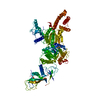
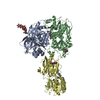
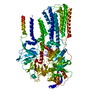

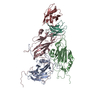
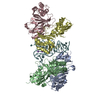

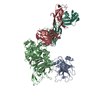
 PDBj
PDBj








